“Agentic warfare is here, whether we welcome it or not. The era of military planners manually gathering limited data and compiling static crisis response options on briefing slides is over. In the next few years, the defense community will see the emergence of AI agents representing military planners, logisticians, intelligence officers, and operators that harness centuries of stored experience in real-time digital collaboration, generating uniquely effective crisis solutions for human decision-makers in seconds. This is not just an incremental improvement — it is a seismic shift. First-mover advantage in leveraging this capability will not merely ensure battlefield dominance — it will be overwhelmingly decisive at every level of warfare. It could herald the dawn of a new defense paradigm, supplanting the outdated defense-industrial complex with an agile, AI-driven agentic base. The stakes could not be higher: If the United States and free nations do not seize this first-mover advantage, they will be outpaced and outmaneuvered by adversaries who may impose their authoritarian control on a global scale.” — Agentic Warfare Is Here. Will America Be the First Mover? War on the Rocks, 23 April 2025.
[Editor’s Note: The article cited above predicts that agentic capabilities — i.e., those Artificial Intelligence (AI) systems that can operate independently, making decisions and executing actions without constant human supervision — when “employed by [our] adversaries… will dramatically outperform traditional Western paradigms of 24- to 72-hour decision cycles and wartime initiative. Once adversaries learn how to employ these capabilities and move to the level of artificial general intelligence — and, eventually, superintelligence — there will be no ability to recover lost ground.”
Today’s submission by returning guest blogger and proclaimed Mad Scientist Dr. James Giordano and Elise Annett explores how our Joint Force, its constituent Services, and our Allies and Partners can rise to meet this Operational Environment challenge through the “prioritized strategic integration of AI and battlefield autonomy within U.S. military systems” — tempered by “human agency and accountability.” They astutely observe, “Decisive tactical and strategic advantage will not hinge upon massed firepower, but on cognitive speed, operational agility, and the fusion of advanced technologies with human command.” This, in turn, will require us to transform and inculcate a culture of anticipation, innovation, and rapid technological adaptation. Dr. Giordano and Ms. Annett provide us with three recommendations that will empower us to meet (and beat!) our adversaries — Read on!]
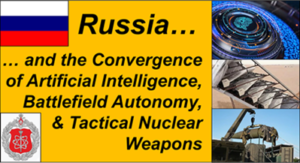 Charlotte Feit-Leichman’s urgent and incisive analysis — Russia and the Convergence of AI, Battlefield Autonomy, and Tactical Nuclear Weapons1 — highlighted a critical and destabilizing trend in modern warfare: the convergence of AI, battlefield autonomy, and tactical nuclear weapons. The accelerated adoption of these technologies, along with a shift in critical decision-making processes, creates an environment conducive to escalation, wherein miscalculations could lead to unpredictable consequences.
Charlotte Feit-Leichman’s urgent and incisive analysis — Russia and the Convergence of AI, Battlefield Autonomy, and Tactical Nuclear Weapons1 — highlighted a critical and destabilizing trend in modern warfare: the convergence of AI, battlefield autonomy, and tactical nuclear weapons. The accelerated adoption of these technologies, along with a shift in critical decision-making processes, creates an environment conducive to escalation, wherein miscalculations could lead to unpredictable consequences.
Ms. Feit-Leichman provides a strong foundation for understanding the threat posed by these technologies, and China’s engagement in these domains provides yet another example of the risk and threats posed by current peer-competitors.2 China’s strategic embrace of military and technological  innovation has weaponized AI, embedding machine intelligence deep within its strategic command and control structures.3, 4 China’s quantum-secured communications signal both military preparedness and a calculated effort to outmaneuver the United States, if not the West at large.5, 6 The speed at which China has embedded AI in its military apparatus and its use of cutting-edge technologies to reshape global influence is a clear indication of their impending domination of technological warfare, and through such means, a redefinition of the global order.7 Thus,
innovation has weaponized AI, embedding machine intelligence deep within its strategic command and control structures.3, 4 China’s quantum-secured communications signal both military preparedness and a calculated effort to outmaneuver the United States, if not the West at large.5, 6 The speed at which China has embedded AI in its military apparatus and its use of cutting-edge technologies to reshape global influence is a clear indication of their impending domination of technological warfare, and through such means, a redefinition of the global order.7 Thus,  China’s success in this space underscores the necessity of rapid, integrated technological adaptation if the U.S. is to maintain any equivalence of tactical military capability, and any realistic consideration of strategic parity.
China’s success in this space underscores the necessity of rapid, integrated technological adaptation if the U.S. is to maintain any equivalence of tactical military capability, and any realistic consideration of strategic parity.
Such examples prompt the question of how should the U.S. military respond to these emerging threats upon the landscape of modern conflict? We posit that the answer clearly points to the need for prioritized strategic integration of AI and battlefield autonomy within U.S. military systems; but we add that this 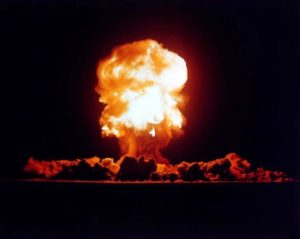 must be done with unwavering commitment to ethical responsibility, human oversight, and strategic foresight. Feit-Leichman rightly warns of the dangers posed by automated decision-making processes in nuclear command, amplifying the risk of error. We agree and add that given the current trends in automation she describes, a prime responsibility is to ensure that these systems complement, rather than replace, human judgment.
must be done with unwavering commitment to ethical responsibility, human oversight, and strategic foresight. Feit-Leichman rightly warns of the dangers posed by automated decision-making processes in nuclear command, amplifying the risk of error. We agree and add that given the current trends in automation she describes, a prime responsibility is to ensure that these systems complement, rather than replace, human judgment.
We assert that the speeds at which autonomous systems operate obliges prioritization of human accountability. Delegating high-consequence decisions to AI systems introduces risk that may not be fully containable. As 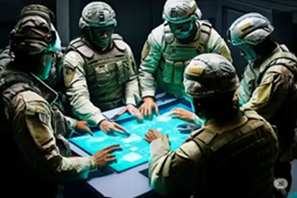 AI and autonomous systems reshape the battlefield, the military should revise training models to emphasize human-machine collaboration in decision-making under conditions of variable uncertainty.8 Failure to maintain human agency and accountability when integrating these technologies will surely result in tactical missteps that could incur considerable strategic risks.
AI and autonomous systems reshape the battlefield, the military should revise training models to emphasize human-machine collaboration in decision-making under conditions of variable uncertainty.8 Failure to maintain human agency and accountability when integrating these technologies will surely result in tactical missteps that could incur considerable strategic risks.
Decisive tactical and strategic advantage will not hinge upon massed firepower, but on cognitive speed, operational agility, and the fusion of advanced technologies with human command.9 Thus, warfighting dominance will be secured by those who think faster, decide with greater clarity, and execute with seamless precision across domains. This is not merely iterative  modernization; rather, it is a strategic mandate for overmatch, deterrence, and survival in the face of accelerating threat trajectories. Toward these ends the U.S. military must anticipate, adapt, and accelerate technological achievement to outpace peer and near-peer adversaries across Land, Air, Sea, Space, Cyber, and Cognitive Domains. [N.B., while the U.S. recognizes and plans for warfighting in the first five of these domains, it is important to note: 1) we don’t recognize cognitive as a separate warfighting domain, while 2) China recognizes both the Cognitive and Electromagnetic Spectrum Domains, in addition to the first five listed here.]
modernization; rather, it is a strategic mandate for overmatch, deterrence, and survival in the face of accelerating threat trajectories. Toward these ends the U.S. military must anticipate, adapt, and accelerate technological achievement to outpace peer and near-peer adversaries across Land, Air, Sea, Space, Cyber, and Cognitive Domains. [N.B., while the U.S. recognizes and plans for warfighting in the first five of these domains, it is important to note: 1) we don’t recognize cognitive as a separate warfighting domain, while 2) China recognizes both the Cognitive and Electromagnetic Spectrum Domains, in addition to the first five listed here.]
To achieve this, we offer the following recommendations:
 1. Innovation cannot be confined to peripheral initiatives, wargaming labs, or specialized units. It must be institutionalized and integrated within every aspect of force design, command architecture, acquisition pipelines, and professional military education.
1. Innovation cannot be confined to peripheral initiatives, wargaming labs, or specialized units. It must be institutionalized and integrated within every aspect of force design, command architecture, acquisition pipelines, and professional military education.
2. The U.S. military must evolve into a reflexively adaptive, mission-driven force that rewrites doctrine on demand, accelerates capability integration at speed, and executes operational pivots before adversaries can detect intent. Innovation is not a supporting function—it is the ![]() primary vector of capability and operational success. It must be acknowledged that the time for adaptation is now. The pace and breadth of technological evolution has surpassed the many aspects of traditional military doctrine. Our adversaries are not preparing for conventional conflict but instead are conducting hybrid highly technologically-enabled operations at present. This acceleration in technological capabilities mandates a shift from reactive to proactive strategies; waiting to adapt is tantamount to conceding defeat.
primary vector of capability and operational success. It must be acknowledged that the time for adaptation is now. The pace and breadth of technological evolution has surpassed the many aspects of traditional military doctrine. Our adversaries are not preparing for conventional conflict but instead are conducting hybrid highly technologically-enabled operations at present. This acceleration in technological capabilities mandates a shift from reactive to proactive strategies; waiting to adapt is tantamount to conceding defeat.
3. The U.S. military must embrace continuous, multidomain warfare, and pivot decisively toward innovation, zero-defect adaptability, and operational supremacy. However, supremacy can be fleeting, and thus, to maintain this edge, the military’s transformation needs to be propelled by and committed to strategic evolution. This commitment needs to be apolitical, forward-looking, and seamlessly integrated across the Joint Force, interagency partners, the private sector, and academic 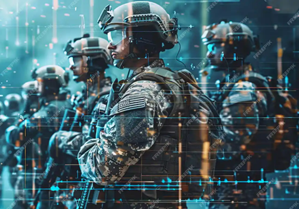 institutions. The future of warfighting demands a paradigm shift, supported by systems-level vulnerability audits and anticipatory assessments. These processes must identify where adversaries may target and exploit seams in U.S. (technical, doctrinal and operational) capability and engage efforts to close these gaps through disruptive strategies.10
institutions. The future of warfighting demands a paradigm shift, supported by systems-level vulnerability audits and anticipatory assessments. These processes must identify where adversaries may target and exploit seams in U.S. (technical, doctrinal and operational) capability and engage efforts to close these gaps through disruptive strategies.10
Such transformation and steps toward strategic superiority will not be achieved by platforms alone. Rather they will require cultivation of a cognitively elite force, oriented and committed to a strategic plan, and trained in tactics, complex systems thinking, ethical foresight, and cross-domain leadership. Moreover, such transformation must extend beyond the military, to engage national policy that supports and sustains technological development, incentivizes dual-use research, and ensures that ethical military innovation remains flexible to outpace adversarial capability.

If you enjoyed this post, review the TRADOC Pamphlet 525-92, The Operational Environment 2024-2034: Large-Scale Combat Operations
Explore the TRADOC G-2‘s Operational Environment Enterprise web page, brimming with authoritative information on the Operational Environment and how our adversaries fight, including:
Our China Landing Zone, full of information regarding our pacing challenge, including ATP 7-100.3, Chinese Tactics, How China Fights in Large-Scale Combat Operations, BiteSize China weekly topics, and the People’s Liberation Army Ground Forces Quick Reference Guide.
Our Russia Landing Zone, including the BiteSize Russia weekly topics. If you have a CAC, you’ll be especially interested in reviewing our weekly RUS-UKR Conflict Running Estimates and associated Narratives, capturing what we learned about the contemporary Russian way of war in Ukraine over the past two years and the ramifications for U.S. Army modernization across DOTMLPF-P.
Our Iran Landing Zone, including the Iran Quick Reference Guide and the Iran Passive Defense Manual (both require a CAC to access).
Our North Korea Landing Zone, including Resources for Studying North Korea, Instruments of Chinese Military Influence in North Korea, and Instruments of Russian Military Influence in North Korea.
Our Running Estimates SharePoint site (also requires a CAC to access) — documenting what we’re learning about the evolving OE. Contains our monthly OE Running Estimates, associated Narratives, and the quarterly OE Assessment TRADOC Intelligence Posts (TIPs).
Then review the following related Mad Scientist Laboratory content addressing our need for rapid and constant innovation:
“Once More unto The Breach Dear Friends”: From English Longbows to Azerbaijani Drones, Army Modernization STILL Means More than Materiel by Ian Sullivan
China’s PLA Modernization through the DOTMLPF-P Lens and How will the RUS-UKR Conflict Impact Russia’s Military Modernization? by Dr. Jacob Barton
Other People’s Wars: The US Military and the Challenge of Learning from Foreign Conflicts and associated podcast, with Brent L. Sterling
Are We Ready for the Post-digital Hyper-war? by Capt Martin Crilly, British Army
Delta-V, by Chris Elles
Innovation at the Edge and associated podcast, with senior military leaders, field and company grade officers, and young Soldier/Innovators from the 3rd Infantry Division, 101st Airborne Division, and 18th Airborne Corps
Keeping the Razor’s Edge: 4th PSYOP Group’s Innovation and Evolution Council, by the 4th Psychological Operations Group (4th POG) Innovation and Evolution Council
The Future of Ground Warfare and associated podcast, with Proclaimed Mad Scientist COL Scott Shaw
The Case for Restructuring the Department of Defense to Fight in the 21st Century, by LTC Christopher J. Heatherly
Strategic Latency Unleashed! and Going on the Offensive in the Fight for the Future
Tactical Innovation: The Missing Piece to Enable Army Futures Command, by LTC Jim Armstrong
Mission Engineering and Prototype Warfare: Operationalizing Technology Faster to Stay Ahead of the Threat by The Strategic Cohort at the U.S. Army Tank Automotive Research, Development, and Engineering Center (TARDEC).
>>>>Reminder 1: You are cordially invited to the Army Mad Scientist Initiative’s “Global Perspectives on the OE: Indo-Pacific” Virtual Event tonight (22 May 2025). Partnering with our U.S. Army TRADOC Foreign Liaison Officers, this virtual event will explore our Allies and Partners’ perspectives on the Operational Environment, featuring prominent subject matter experts from some of our Allies and Partners in the Indo-Pacific theater to establish an open dialogue on their perspectives regarding the Operational Environment. The event will be held from 6:00pm EDT to 11:30pm EDT. Register to attend this event at the Eventbrite link here and check out the agenda here.
Once registered, you will receive a follow-up email with the link to the virtual event.
You must be registered in Eventbrite to receive a virtual event link!
>>>>Reminder 2: Army Mad Scientist wants to crowdsource your thoughts on Great Power Competition & Conflict — check out the flyer describing our latest writing contest.
All entries must address one of the following writing prompts:
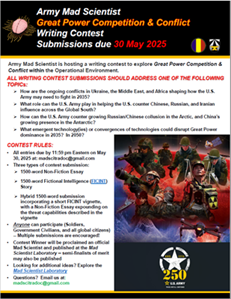 How are the ongoing conflicts in Ukraine, the Middle East, and Africa shaping how the U.S. Army may need to fight in 2035?
How are the ongoing conflicts in Ukraine, the Middle East, and Africa shaping how the U.S. Army may need to fight in 2035?
What role can the U.S. Army play in helping the U.S. counter Chinese, Russian, and Iranian influence across the Global South?
How can the U.S. Army counter growing Russian/Chinese collusion in the Arctic, and China’s growing presence in the Antarctic?
What emergent technology(ies) or convergences of technologies could disrupt Great Power dominance in 2035? In 2050?
We are accepting three types of submissions:
-
-
- 1500-word Non-Fiction Essay
-
-
-
- 1500-word Fictional Intelligence (FICINT) Story
-
-
-
- Hybrid 1500-word submission incorporating a short FICINT vignette, with a Non-Fiction Essay expounding on the threat capabilities described in the vignette
-
Anyone can participate (Soldiers, Government Civilians, and all global citizens) — Multiple submissions are encouraged!
All entries are due NLT 11:59 pm Eastern on May 30, 2025 at: madscitradoc@gmail.com
Click here for additional information on this contest — we look forward to your participation!
About Today’s Authors:
Elise Annett is the Institutional Research, Assessment, and Accreditation Associate at the Eisenhower School for National Security and Resource Strategy; and is a doctoral candidate at Georgetown University. Her work addresses operational and ethical issues of iteratively autonomous AI systems in military use.
Proclaimed Mad Scientist Dr. James Giordano is Director of the Center for Disruptive Technology and Future Warfare of the Institute for National Strategic Studies at the National Defense University, and is Professor Emeritus of Neurology, Biochemistry, and Ethics at Georgetown University Medical Center.
Disclaimer: The views and opinions presented in this essay are those of the authors, and do not necessarily reflect those of the U.S. Government, Department of Defense, National Defense University and/or those organizations and institutions that support the authors’ work. Additionally, they do not necessarily reflect those of the Department of the Army, Army Futures Command (AFC), or Training and Doctrine Command (TRADOC).
1 https://madsciblog.tradoc.army.mil/532-russia-and-the-convergence-of-ai-battlefield-autonomy-and-tactical-nuclear-weapons/
2 Giordano J, Bremseth LR, DeFranco JP. Dual- and non-kinetic use of Chinese brain science: Current activities and future implications. In: Petersen N. (ed.) Chinese Strategic Intentions: A Deep Dive into China’s Worldwide Activities. Department of Defense; Strategic Multilayer Assessment Group- Joint Staff/J-3/Pentagon Strategic Studies Group (November 2019).
3 DeFranco JP, Bremseth LR, DiEuliis D, Giordano J. Emerging bio-technologies for disruptive effects in grey zone engagements. In: Regan M, Sari A. (eds.) Hybrid Threats and Grey Zone Conflict. NY: Oxford University Press, (2024), pp. 237-249.
4 Giordano J, DeFranco JP, Bremseth LR. Radical Leveling and Emerging Technologies as Tools of non-Kinetic Disruption. Department of Defense; Strategic Multilayer Assessment Group- Joint Staff/J-3/Pentagon Strategic Studies Group (February 2021).
5 https://link.springer.com/article/10.1007/s11192-022-04478-4
6 https://www.researchgate.net/profile/Gui-Long/publication/225600434_Quantum_secure_direct_communication_and_deterministic_secure_quantum_communication/links/544587360cf22b3c14dde84b/Quantum-secure-direct-communication-and-deterministic-secure-quantum-communication.pdf
7 https://link.springer.com/article/10.1007/s11192-022-04478-4
8 https://doi.org/10.1080/14751798.2023.2264070

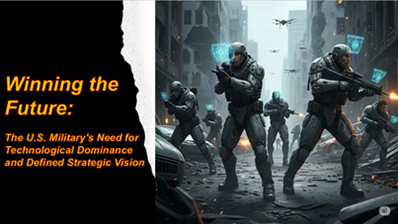


This is a truly compelling analysis of how the fusion of cognitive speed and autonomous systems is rapidly redefining strategic advantage. The shift toward agentic warfare you describe isn’t just military—it’s already reshaping how civilian sectors operate, too.
At https://thsld.com/ we’ve been applying similar principles of automation and real-time decision modeling in the property technology space. While far from battlefield conditions, it’s clear that the pace of AI evolution requires leaders in every domain—military or civilian—to proactively adapt and integrate emerging technologies before adversaries or competitors do.
Appreciate the clarity and urgency in this piece. Looking forward to reading more from Dr. Giordano and Ms. Annett.